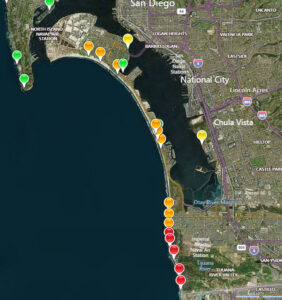
The Coronado and Silver Strand shorelines are under advisory again after water bacteria levels exceeded state standards over the weekend as projects to address the Tijuana sewage crisis trudge forward on both sides of the border.
In Mexico, a ruptured 42-inch wastewater pipe is expected to be repaired by November. It ruptured last summer, adding to the flow of untreated wastewater from Tijuana into coastal waters and across the U.S.-Mexico border.
A replacement pipe has been delivered to Matadero Canyon (also known as Smuggler’s Gulch) in Mexico to address the break, according to Frank Fisher, public affairs chief for the U.S. Section of the International Boundary and Water Commission.
“This should result in reduced flows to the Tijuana River and the South Bay International Wastewater Treatment Plant,” Fisher said. “The plant has been treating volumes of Mexican sewage beyond its design capacity off and on since the pipeline ruptured as we tried to minimize untreated wastewater flows entering the United States.”
Meanwhile, after the San Diego County Board of Supervisors declared a local state of emergency due to the crumbling infrastructure that prompts widespread beach closures in south county, Congressional representatives are pushing for action.
Representative Scott Peters (CA-50) has led a request that Michael Regan, administrator for the Environmental Protection Agency, find ways to divert funding to stop the problem. Mitigation efforts do not have sufficient funding to fully address the problem.
“The people of San Diego County have suffered with this for far too long and are counting on us to find a sustainable solution,” Peters wrote in a letter to Regan, on which he was joined by Representatives Juan Vargas (CA-52), Sara Jacobs (CA-51), and Mike Levin (CA-49).
Peters in June wrote a letter to Marina del Pilar Ávila, governor of Baja California, asking for clearer timelines on repairs Mexico committed to on its side of the border.
In June, Peters, Vargas, Jacobs, and Levin joined the county supervisors in calling for both state- and federal-level emergency declarations for the Tijuana River Valley.
At press time, representatives from Governor Gavin Newsom’s office had not replied to inquiries regarding his stance on the matter.




